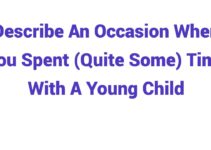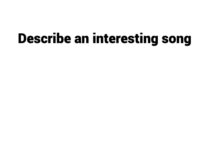
Table of Contents
Describe a Historical Period/Moment You Would Like To Learn More About
Cue Card
You should say:
- What you are interested in
- When it happened
- What you know about it
- And why you would like to learn more
Sample Answers 1
I would like to know more about the ‘regency period‘ in England. This happened in the late 18th and early 19th Centuries. A famous author called Jane Austen wrote all her books about this period and I love her work. Especially ‘Pride and Prejudice‘, and the character called Elizabeth Bennet. Jane Austen and Elizabeth Bennet are inspirations for me.
What I know about this period comes from the novels I have read. It seems like a very peaceful and quiet time period, as machines had not been invented yet. There were lots of balls, dancing, romantic music, poetry, and distinct fashion style. Additionally, it was a fairly politically stable period in England. The society in this time period seems like it was very refined.
I would love to learn more about it, for instance what life was really like for people without all the technologies we are accustomed to these days. I am sure it would have been much simpler but also more difficult in many aspects. I think it is important for people to realise what we have gained in the era of modern tech, but also what we have lost. Because the regency time period happened just before the industrial revolution, I think this would be the best time to experience what life was like before machines.
Sample Answers 2
Well, I’m going to talk about the swinging fifties, which I think was around like 1950 to 1965. As far as I’m aware, It is the most elegant era of western costume. In those days, Hepburn began her film career in 1948 in the Netherlands in Seven Lessons, a 39-minute documentary on Dutch scenery.
In 1953, she starred in the film Roman Holiday for the first time and won an Oscar for best actress. In the same year, she won the Tony award for best actress for her performance in the play The Mermaid. And in 1961, she starred in the movie Breakfast at Tiffany’s.
What strikes me is the clothes Hepburn wore in those films. For example, the hourglass skirt with noble, elegant fashion style highlights the magnificent posture of the round cap and waist. The cocktail dress is a kind of between the casual and formal evening dress clothes, because the clothing is compact, casual, and make the wearers look younger, so it was welcomed by all levels of different age women.
And the inspiration for these kinds of clothes piques my interest a little bit. So I’d love to know what started this fashion trend. Was it one particular personal? One particular movement?
What’s the story behind the brands of these dresses? What did this period of time mean to people?
So even though I don’t know a lot about it, I go online to do some research when I get a spare five minutes and find out everything related to that period of time.
Sample Answers 3
The Tang Dynasty in ancient China is a period of history that has always piqued my interest and left me eager to delve deeper into its rich and captivating history. Spanning from 618 to 907 AD, the Tang Dynasty is considered to be one of the golden ages of Chinese civilization and is renowned for its artistic, cultural, and economic achievements.
Despite having a basic understanding of the Tang Dynasty, I would like to delve deeper into its fascinating history and learn more about the events that shaped this remarkable era. From what I know, the Tang Dynasty was a time of great political stability and military expansion, marked by its diplomatic relations with other countries and its tolerant approach towards different cultures and religions.
I am particularly interested in learning about the role of women during the Tang Dynasty. During this time, women were granted greater rights and freedoms compared to other periods in Chinese history, and played important roles in society, including serving as government officials and even military commanders. It would be fascinating to learn more about the experiences of women during this time and how they shaped the culture and society of ancient China.
Furthermore, the Tang Dynasty was known for its art, poetry, and music, and I would love to learn more about this aspect of its history. I have heard of the famous poet Li Bo and his contributions to Chinese literature, and I am eager to explore his works and those of other writers and artists of the era.
Lastly, I would like to learn more about the fall of the Tang Dynasty and the events that led to its eventual decline. I have heard that the Tang Dynasty was followed by a period of political and social turmoil, which marked the end of this golden age in Chinese history. Understanding the causes of the
‘Tang Dynasty’s decline would provide a more complete and nuanced understanding of this fascinating period in history.
Overall, the Tang Dynasty in ancient China is a period that holds a wealth of knowledge and cultural significance, and I am eager to delve deeper into its rich history. From its political stability and military expansion, to its artistic achievements and the role of women, there is much to learn and discover about this captivating era in Chinese history.
Part 3
1. Should everyone know history?
Not necessarily. It demands a huge amount of efforts and time to having a deep and thorough understanding of history. For those who are less enthusiastic about history, learning history would be a misery.
Nevertheless, I must say it is useful to learn history. If you encounter problems in reality, you can probably look for solutions from history.
Moreover, learning history can get us acquainted with all kinds of heroes and heroines, teaching us to be brave and persevere.
2. In what ways can children learn history?
There are a variety of ways.
Obviously, children can learn history by taking a history course.
But in the long run, the best way for children to learn history is to truly arouse their interest, for example, parents can instill the value and fun of some historical figures and stories into their children.
3. What are the differences between learning history from books and from videos?
Well, watching historical TV plays can help people to know about history. They are interesting and easy to understand. Both the old and the young have a lot of fun watching them.
By contrast, reading books about history is also a good way to learn about history. These books can tell them the true story. People can learn and think a lot from them while reading.
4. Is it difficult to protect and preserve historic buildings?
Well, I reckon it is quite difficult and daunting since the buildings and structures are often old and fragile. It brings together various experts and professionals.
When they work with historical sites, they have to do feasibility research and navigate a myriad of local and national regulations, otherwise the buildings would be damaged.
5. Who should be responsible for protecting historic buildings?
Everyone should try to protect historic buildings.
As they are symbols of a city or a country and embody local culture. These buildings can instill a sense of pride in locals, heighten their cultural identity and give them greater sense of belonging.
Furthermore, old historic buildings with local characteristics will attract many visitors, which facilitates the development of tourism.
On top of that, these old buildings with historical and cultural values are architecturally valuable for unique features that help experts in their architectural studies.
6. Who should pay for the preservation of historic buildings?
Well, I think government should support cultural or historical attractions financially to keep them going, because the resident population already pays money for protecting historic buildings through the tax system.
Some IELTS Speaking part 2 cue-cards you may like :
Credits
Image : Photo by Michal Soukup on Unsplash


